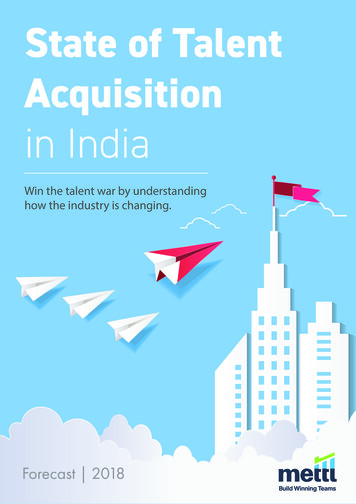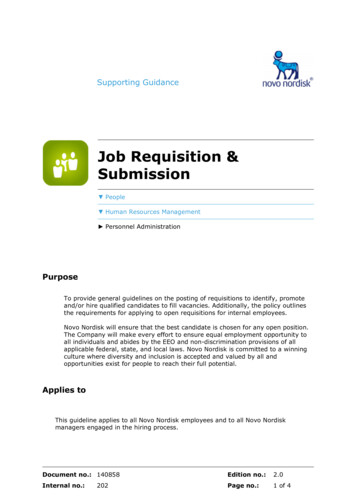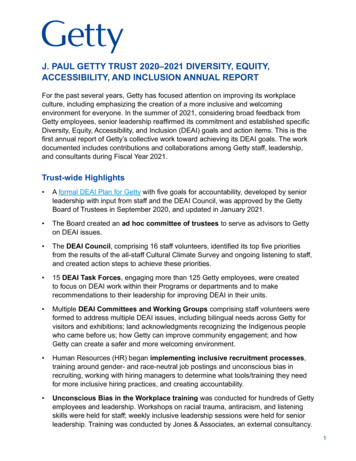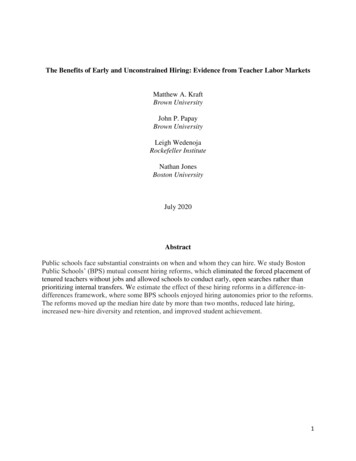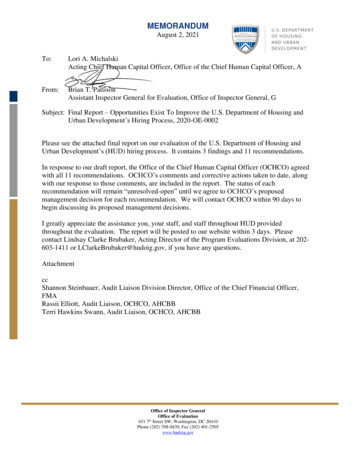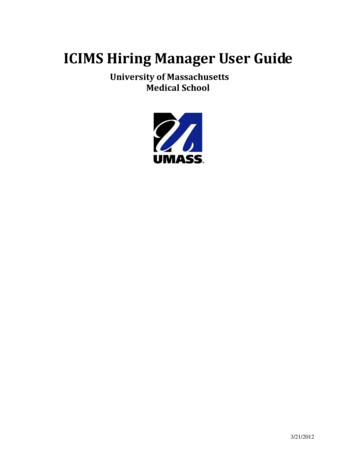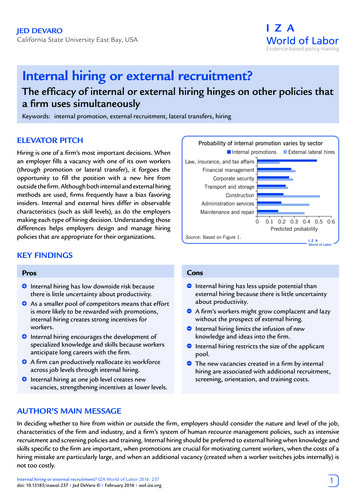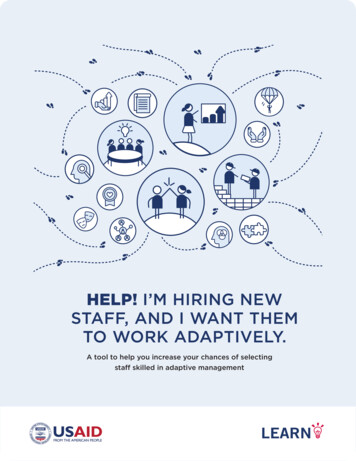
Transcription
HELP! I’M HIRING NEWSTAFF, AND I WANT THEMTO WORK ADAPTIVELY.A tool to help you increase your chances of selectingstaff skilled in adaptive management
WHAT CAN THIS TOOL HELP ME WITH?If you are involved in hiring, this tool can help you increase your chances of selecting staffmembers skilled in adaptive management. It will help answer the questions:Which competencies should I recruit for in order to hiremore adaptive employees?Which desired qualifications should I incorporate intoposition descriptions to attract adaptive employees?Which interview questions should I ask to screen foradaptive employee competencies?You should use this tool when you decide to hire a new individual - whether that be adirect hire, contractor, or consultant - or when you are changing an individual’s currentposition description or scope of work. Specifically, this tool will help you determine whichqualifications are most important for the position and offers interview questions you canuse with candidates. USAID staff can also use this tool to consider what types of skills theywant to see incorporated into solicitations for key personnel.If you have any questions about or suggestions for this tool,please reach out to LabEIA@usaid.gov.2
WHAT IS AN ADAPTIVE EMPLOYEE?Individuals, regardless of title1, who in collaboration2with relevant stakeholders, systematically3 acquire anduse knowledge to make decisions and adjustments4in their work in order to achieve greater impact5.1REGARDLESS OF TITLEAnyone at any level can manage adaptively and have an adaptiveskill set.2COLLABORATIONNo one achieves results alone; adaptive employees workeffectively and collaboratively with others.3SYSTEMATICALLYAdaptive employees are consistent, proactive, and intentionalabout how they approach their work.4ACQUIRE AND USE KNOWLEDGE TO MAKE DECISIONS ANDADJUSTMENTSAdaptive employees use knowledge to inform their decisionsand, importantly, take action (i.e., make adjustments).5IMPACTAdaptive employees stay focused on achieving meaningfulresults; this is their north star and what guides their decisions tomake adjustments to their work.3
WHY DO ADAPTIVE EMPLOYEES MATTER?With industries, technologies, and organizations in a near constant state of flux, leaders arerecognizing the importance of adaptability. Along with the intelligence quotient (IQ) andemotional intelligence (EI), the adaptability quotient (AQ) - defined as the “ability to adaptto and thrive in an environment of change” - is gaining recognition as a critical capacity.Because of this, it is not surprising that a recent LinkedIn report found that adaptability wasthe most important soft skill hiring managers were screening for.Within the field of international development, there is a growing recognition that staff needadaptive management skills in addition to strong technical or sector-specific skills. USAID isin many ways leading the charge and has elevated the importance of adaptive managementthrough a variety of high level policies and frameworks, including the integration ofcollaborating, learning, and adapting (CLA) throughout the Program Cycle (ADS 201), theAgency’s Policy Framework, Acquisitions and Assistance Strategy, leadership philosophy,and Risk-Appetite Statement.Evidence also shows that teams that apply more data-driven and adaptive leadershippractices perform better compared to those that focus less on those practices. It’s nosurprise then that managers want to recruit more team members who are skilled in adaptivemanagement—it helps achieve results.The following page provides a synthesis of the key adaptive employee behaviors, mindsets,and competencies. It is based on research from multiple sources on adaptive managementand HR competencies, including USAID, DfID, World Bank, Bond, Engineers without Borders,Mercy Corps, agile leadership competencies, and Lominger competencies.4
ADAPTIVEI care and ammotivatedEMPLOYEESBEHAVIORS, MINDSETS,AND COMPETENCIES*I am humbleand relationshiporientedListeningSystemsThinkingVision &CommitmentAssessing,Taking &Managing RiskVulnerability& CourageFOCUSES ON RESULTSAND IMPACTManaging &MeasuringWorkInstead of:Checkingthe boxInclusiveLeadership FACILITATES LEARNINGConflict Prevention& ManagementI have a growthmindset and I amsolution orientedAND BUILDSRELATIONSHIPSInstead of:Directing by usingown experienceCritical &ReflectiveThinkingPoliticalAcumenCuriosityI am ready for thechange that maycome our wayProblemSolvingCONTINOUSLYLEARNS ANDIMPROVESDecisionQualityChangeManagementComfort withAmbiguityInstead of:Maintainingthe status quoNAVIGATES CHANGEEmotionalResilienceInstead of:Resisting changeFlexibilitySelf-awareness& PersonalImprovement* Based on desk research from multiplesources on adaptive management and HRcompetencies. Sources include USAID,DfID, World Bank, Bond, Engineers WithoutBorders, Mercy Corps, agile leadershipcompetencies, and Lominger competences.What is an Adaptive Employee?Individuals, regardless of title, that in collaboration with relevant stakeholders,systematically acquire and use knowledge to make decisions and adjustmentsin their work in order to achieve greater impact.5
WHICH COMPETENCIES SHOULD I RECRUIT FOR INORDER TO HIRE MORE ADAPTIVE EMPLOYEES?Not all positions will require highly skilled adaptive employees. Likewise, not all positions that needadaptive employees require the same competencies. The decision tree below will help you determinewhich adaptive employee competencies (found on the previous page) would be most relevant to theposition. If you’re not sure how to answer the questions in the decision tree, speak with your colleagues,especially those who have been in similar positions.1. DO I NEED TO HIRE AN ADAPTIVE EMPLOYEE?Will s/he be managinghighly complexsituations and work?NO, the workis prettystraightforward.ORWill s/he have tonavigate multiplepathways to success?ORNO, there area limited orknown number ofsolutions.Will s/he haveto deal withlots of change?NO, the work isexpected to bestable.YES, I need to hire an adaptive employee2. WHICH ADAPTIVE COMPETENCIES ARE MOST RELEVANT FOR THIS POSITION?Is this a formalleadership position?YES, consider competenciesmost relevant to leadershipsuch as vision & commitment,inclusive leadership, politicalacumen, vulnerability & courage,decision quality, self-awareness& personal improvement, andchange management.NO, consider competenciesthat are relevant regardless ofposition such as critical thinking,listening, managing & measuringwork, and flexibility.Does the existing teamalready have strong adaptivemanagement capacity?YES, considercompetencies thatwould complementthe team.NO, consider competenciesthat would build the team’sadaptive capacity suchas vision & commitment,change management, andvulnerability & courage.Will the position requireextensive collaboration witha variety of stakeholders?YES, consider competencies thatpromote effective relationshipbuilding such as political acumen,conflict prevention & management,listening, problem solving, andsystems thinking.NO, consider competenciesthat may be relevant for moreindividualized work, such asassessing, taking, and managingrisk, measuring & managing work,emotional resilience, criticalthinking, curiosity, and flexibility.There are a variety of considerations that could affect which competencies you select, and the aboveconsiderations don’t provide an exhaustive list of relevant competencies. Use your knowledge of your particularsituation to select the competencies that are most relevant to the position and the needs of your team.6
WHICH DESIRED QUALIFICATIONS SHOULD I INCORPORATE INTOPOSITION DESCRIPTIONS TO ATTRACT ADAPTIVE EMPLOYEES?Vision & Commitment: Ability to articulate a clearvision of what should be accomplished and how andto persevere to achieve resultsSystems Thinking: Ability to understand, affect,connect, and leverage various parts of a system whilemaintaining sight of the whole systemTaking & Managing Risk: Ability to determinewhether new ideas are worth pursuing and developprocesses to assess whether they are bearing resultsFOCUSES ONRESULTS ANDIMPACTAssessing, Managing & Measuring Work: Ability toset clear objectives, coordinate resources, people,and processes, and manage feedback loops to adjustapproaches as necessaryListening: Ability to actively listen (i.e., seeks tounderstand, asks good questions, paraphrases, and isin tune with speaker’s emotional state)Vulnerability & Courage: Ability to share lack ofknowledge, mistakes, or failures; give and receivefeedback; and raise difficult questions or concernsInclusive Leadership: Ability to work collaborativelywith all kinds of people and make those you workwith feel valued and part of the team regardless ofFACILITATESLEARNING & BUILDSRELATIONSHIPSbackground or rolePolitical Acumen: Ability to maneuver throughcomplex political situations, demonstrating anunderstanding of power relations and sensitivity tohow people and organizations functionConflict Prevention & Management: Ability toproactively identify potential disagreements, noticeexisting disagreements, tactfully bring them into theopen, and support others in expanding areasof agreement7
WHICH DESIRED QUALIFICATIONS SHOULD I INCORPORATE INTOPOSITION DESCRIPTIONS TO ATTRACT ADAPTIVE EMPLOYEES?Curiosity: Ability to articulate and explore novelareas of learning that would contribute to greatereffectivenessCritical & Reflective Thinking: Ability to analyze andunderstand situations from a variety of perspectivesDecision Quality: Ability to make quality decisionsbased on a mixture of analysis, evidence, andexperience.CONTINUOUSLYLEARNS ANDIMPROVESProblem Solving: Ability to weigh information andoptions and determine the most appropriate and highimpact solutions to complex challengesSelf-awareness & Personal Improvement: Abilityto recognize and develop personal strengths andareas in need of improvement and adjust style andapproach depending on what the situation requiresComfort with Ambiguity: Ability to deal with a lackof clarity in role definition, work processes, anddecision-making and to create clarity for others whenlittle existsFlexibility: Ability to accept the unexpected andadjust to what the situation now requires rather thanwhat was plannedEmotional Resilience: Ability to stay composed andact as a calming influence through difficult situations,NAVIGATESCHANGEcrises, or periods of changeChange Management: Ability to identify, manage,initiate, and influence change and manage andsupport others through change. That change maybe brought about by external factors beyond theircontrol or because they recognize a need to changeto achieve greater and more sustained results.8
WHAT INTERVIEW QUESTIONS SHOULD I ASK TOSCREEN FOR ADAPTIVE EMPLOYEE COMPETENCIES?Interviewing candidates is an opportunity to assess the extent to which they could manageadaptively if you hire them. This section provides sample interview questions you can use. Aswith the qualifications earlier, select interview questions based on the most relevant adaptiveemployee competencies given the nature of the position and composition of the existing team.Some interview questions below include “green” and “red” flags; green refers to what youwould want to hear from the candidate and red the opposite.Many of these questions are considered behavioral interview questions, requiring candidatesto provide specific examples where they exhibited certain behaviors. Do not be surprisedif candidates need a few moments to come up with examples. Remain comfortable in thesilence while they consider the question. Feel free to ask follow-up questions to gain greaterclarity about the situation and the candidate’s response to it.GeneralNote that the interview is an opportunity to check for the listening and curiositycompetencies.Listening:Are interviewees listening to your questions and responding withrelevant information? If you are providing information to theinterviewee, are they incorporating what is important to you intotheir responses?Curiosity:Does the interviewee have relevant questions for you, indicatingtheir curiosity about the position and organization?1Tell me about a time you demonstrated (insert adaptiveemployee competency you are interested in hearing more about).2Give me an example of a time when you felt you led by example. What didyou do and how did others react?1GREEN FLAGRED FLAG1Interviewee provides an example that demonstrates one ofthe adaptive manager competencies.Interviewee provides an example that is not aligned with theteam or organization’s values.LinkedIn, 2017. 30 Behavioral Interview Questions to Identify High Potential Candidates.9
Facilitates learning andbuilds relationships1Tell me about one of your favorite experiences collaborating within a team, withanother team, or with another organization. What was your contribution to makingthat an effective collaboration?Competencies: potentially listening, vulnerability & courage,inclusive leadership, and political acumen2Tell us about a time when you had to deal with a challenging relationship and/orsituation but did not have formal authority.Competencies: political acumen, inclusive leadership, flexibility,comfort with ambiguity, conflict prevention & management3Ask the candidate to explain something complex in a simple way; the candidateselects the topic and must also engage you in the explanation in some way. Providethe candidate with five minutes to prepare (and a flip chart, markers, post-its,etc.) and 3-5 minutes to explain. You can leave the room as they prepare. After thediscussion, ask the candidate to reflect on what went well and what could havegone better.Competencies: inclusive leadership, vulnerability & courage, comfort withambiguity, decision quality, emotional resilience, critical & reflective thinkingGREEN FLAGCandidate communicates clearly and makes the interviewer(s) feelincluded in the discussion. Candidate is able to identify strengthsand areas of growth that align with the interviewers’ assessment.RED FLAGCandidate does not present confidently, is unclear, etc., anddoesn’t engage the interviewers. Candidates’ assessment ofperformance misaligned to that of interviewers’.4When was the last time you asked for direct feedback from a peer or superior?What prompted you to ask for feedback?2Competencies: vulnerability & courage, listeningGREEN FLAGCandidate requested feedback to improve themselves, theirworking relationships, and/or overall results without it beingrequired.RED FLAGCandidate was forced to request feedback as part of a standardperformance review process.2LinkedIn, 2017. 30 Behavioral Interview Questions to Identify High Potential Candidates.10
Continuously learnsand improves1Can you tell me about your most recent failure or mistake? What did you learnfrom the experience? How have you applied what you learned since then?Competencies: self-awareness & personal improvement, critical &reflective thinking, vulnerability & courage2Describe how you expand your knowledge and skill base at work. Whenwas the last time you intentionally did this? What prompted you to do this?How did you use your new knowledge or skill?3Competency: curiosity, self-awareness & personal improvementGREEN FLAGRED FLAG3Candidate describes ongoing learning approaches andlearning from peers.Candidate describes one-off instances of learning (i.e., atraining) rather than an intentional and systematic approachto continuous learning and improvement.Present the candidate with a real, current challenge being faced by theteam/office - it could be strategic or operational. Ask them to generate asmany alternatives as possible (provide 2-5 minutes of prep time) and makeit clear they are being assessed on the breadth/range of options. After thediscussion, select an idea and ask the candidate to talk through the possibledownstream consequences of implementing it, both positive (intended) andnegative (unintended).4Competencies: critical & reflective thinking, problem solving, systemsthinking, decision quality3LinkedIn, 2017. 30 Behavioral Interview Questions to Identify High Potential Candidates.4 Beam Exchange. Accessed 2018. Traditional Interview Questions.11
Navigateschange1When you suffer a setback or series of setbacks, what are some strategiesyou use to cope with the stress?1Competency: emotional resilienceGREEN FLAGRED FLAG2Candidate intentionally integrates strategies that promotelong-term, personal well-being indicating capacity to dealwith challenging circumstances.Candidate fails to articulate clear strategies for dealingwith setbacks.Tell me about a time when you were required to change an approachor plan on-the-fly (i.e., in the moment with very little warning). Whathappened and what did you do?Competencies: flexibility, comfort with ambiguity, decision quality3Tell me about a time when you initiated substantive change in your team ororganization. What was the change, how did you manage it, and what werethe outcomes?Competencies: change management5 Adapted from University of Southern Maine. Accessed 2018. Competencies Listing with Sample BehaviorBased Questions.Don’t forget about reference checks!Reference checks are another opportunity to learn more aboutpotential candidates and help validate what you hear directlyfrom candidates. You can use variations of the interviewquestions above when checking references.12
WHAT ABOUT EXISTING STAFF?This tool is focused on bringing on new team members, but what about existing staff? Whatresources can help them gain greater skills in adaptive management?FOR USAID STAFF: Take the online Introduction to Collaborating, Learning & Adapting in the Program Cycle;register in USAID University. Take the 5-day, in-person Better Development through Collaborating, Learning & Adaptingtraining; register in USAID University. Join the Collaborating, Learning & Adapting Community of Practice to share with and gainadaptive management resources from colleagues; to join, email learning@usaid.gov. Update your individual learning and training plan in USAID University to include a focus onadaptive employee competencies.FOR EVERYONE: Take the online Introduction to Collaborating, Learning & Adapting in the Program Cycle;find it on usaidlearninglab.org. Check out the Collaborating, Learning & Adapting toolkit (usaidlearninglab.org/cla-toolkit),specifically the section on Adaptive Management.We would love to hear from you!We are considering investing additional resources in tools like this one.Your feedback will help inform that decision. Did this tool help you?How? What can be improved? What else do you you need help with?Please send your comments and suggestions to LabEIA@usaid.gov.13
This document was produced for review by the United States Agency for International Development (USAID). It wasprepared with funding from the U.S. Global Development Lab by the USAID LEARN mechanism. USAID LEARN ismanaged by Dexis Consulting Group and its partner, RTI International.14
crises, or periods of change . Change Management: Ability to identify, manage, initiate, and influence change and manage and support others through change. That change may be brought about by external factors beyond their control or because they recognize a need to change to achieve greater and more sustained results. 8

